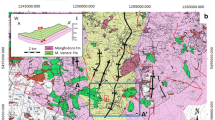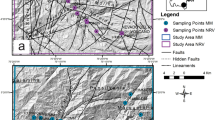Abstract
In order to protect public supply wells from a wide range of contaminants, it is imperative to understand physical flow and transport mechanisms in the aquifer system. Although flow through fractures has typically been associated with either crystalline or carbonate rocks, there is growing evidence that it can be an important component of flow in relatively permeable sandstone formations. The objective of this work is to determine the role that fractures serve in the transport of near-surface contaminants such as wastewater from leaking sewers, to public supply wells in a deep bedrock aquifer. A part of the Cambrian aquifer system in Madison, Wisconsin (USA), was studied using a combination of geophysical, geochemical, and hydraulic testing in a borehole adjacent to a public supply well. Data suggest that bedrock fractures are important transport pathways from the surface to the deep aquifer. These fractured intervals have transmissivity values several orders of magnitude higher than non-fractured intervals. With respect to rapid transport of contaminants, high transmissivity values of individual fractures make them the most likely preferential flow pathways. Results suggest that in a siliciclastic aquifer near a public supply well, fractures may have an important role in the transport of sewer-derived wastewater contaminants.
Résumé
Afin de protéger des puits publics d’alimentation contre une large gamme de polluants, il est impératif de comprendre le flux physique et les mécanismes de transport dans le système aquifère. Bien qu’un flux à travers des fractures ait été typiquement associé à des roches soit cristallines soit carbonatées, il y a une évidence grandissante qu’il peut être une composante importante de flux dans des formations gréseuses relativement perméables. L’objectif de ce travail est de déterminer le rôle que les fractures jouent dans le transfert de contaminants de sub-surface, tels que eaux usées d’égouts fuyants, à des puits d’alimentation dans un substrat aquifère profond. Une partie du système aquifère de Madispn, Wisconsin (USA) a été étudié en utilisant une combinaison de tests géophysique, géochimique et hydraulique dans un forage adjacent à un puits d’alimentation publique. Les données suggèrent que les fractures du substrat sont des chemins importants de passage depuis la surface à l’aquifère profond. Ces intervalles fracturées ont une transmissivité d’ordre de grandeur plusieurs fois supérieure à celle des intervalles non fracturés. En raison du transport rapide des contaminants, des valeurs de transmissivité élevées des fractures singulières en font les chemins préférentiels les plus vraisemblables. Les résultats suggèrent que dans un aquifère silicaté près d’un puits d’alimentation public, des fractures peuvent avoir un rôle important dans le transport de contaminants d’eau résiduaire provenant d’égouts.
Resumen
Con el objeto de proteger a los pozos de abastecimiento público de un amplio rango de contaminantes, es imperativo entender los mecanismos físicos de transporte y flujo en el sistema acuífero. Aunque el flujo a través de las fracturas ha sido típicamente asociado con rocas cristalinas o bien carbonáticas, hay una evidencia creciente que ello puede ser una importante componente de flujo en formaciones de areniscas relativamente permeables. El objetivo de este trabajo es determinar el rol que desempeñan las fracturas en el transporte de contaminantes en las proximidades de la superficie, tales como aguas residuales proveniente de las pérdidas de alcantarillas, a pozos de abastecimiento público en un acuífero de basamento profundo. Se estudió una parte del sistema acuífero cámbrico en Madison, Wisconsin (EEUU), usando una combinación de ensayos geofísicos, geoquímicos, e hidráulicos en una perforación adyacente a un pozo de abastecimiento público. Los datos sugieren que las fracturas del basamento son trayectorias importantes de transporte desde la superficie al acuífero profundo. Estos intervalos fracturados tienen valores de transmisividad de varios órdenes de magnitud más altos que los intervalos de rocas no fracturadas. Con respecto al transporte rápido de los contaminantes, altos valores transmisividad de las fracturas individuales hacen a ellas probablemente las mayores trayectorias de flujo preferencial. Los resultados sugieren que en un acuífero silicoclástico cercano a un pozo de abastecimiento público, las fracturas pueden tener un rol importante en el transporte de contaminantes provenientes de aguas residuales de las alcantarillas cloacas.
摘要
为防止公共供水井受到各种污染物污染,了解含水层系统中物理流动和运移机理是必要的。尽管裂隙中的流动代表性地与结晶岩或碳酸岩相联系,越来越多的证据表明它可以是相对可渗透的砂岩地层中流动的重要组成部分。本文旨在确定近地表污染物运移中裂隙所起的作用,比如从渗漏下水道到深层基岩含水层中的公共供水井的污水。利用地球物理、地球化学以及公共供水井附近钻孔液压测试相结合的手段对美国威斯康星州麦迪逊市部分寒武系含水层系统进行研究。数据表明基岩裂隙是从地表到深部含水层的重要运移路径。有裂隙的区间导水系数比无裂隙区间高若干个数量级。考虑到污染物的快速运移,个别裂隙的高导水系数使它们成为最可能优先运动路径。结果表明在靠近公共供水井的硅质碎屑含水层中,裂隙在下水道起源的污水污染物运移中起重要作用。
Resumo
Com o objetivo de proteger os furos de captação de abastecimento público de uma grande variedade de contaminantes, é imperativo compreender o fluxo físico e mecanismos de transporte no sistema aquífero. Embora o fluxo através de fraturas tenha sido associado tipicamente a rochas cristalinas ou a rochas carbonatadas, existe uma evidência crescente de que ele possa ser uma componente importante do fluxo em formações granulares relativamente permeáveis. O objetivo deste trabalho é determinar o papel que as fraturas assumem no transporte subsuperficial de contaminantes, tais como águas residuais provenientes da drenagem de esgotos para furos de abastecimento público que captam um aquífero rochoso profundo. Uma parte do sistema aquífero Câmbrico, em Madison, Wisconsin (EUA), foi estudada usando uma combinação de ensaios geofísicos, geoquímicos e hidráulicos num furo adjacente a uma captação de abastecimento público. Os dados sugerem que as fraturas no maciço são importantes vias de transporte a partir da superfície para o aquífero profundo. As zonas fraturadas têm valores de transmissividade várias ordens de magnitude mais elevados que as zonas não-fraturadas. Valores elevados de transmissividade em fraturas individuais torna-as nos caminhos preferenciais de fluxo em relação ao transporte rápido de contaminantes. Os resultados sugerem que, num aquífero siliciclástico perto de uma captação de abastecimento público, as fraturas podem ter um papel importante no transporte de contaminantes com origem no esgoto de águas residuais.










Similar content being viewed by others
References
Advanced Logic Technologies (2009) WellCAD version 4.3. User’s manual. Advanced Logic Technologies, Redange-sur-Attert, Luxembourg
Aswasereelert W, Simo JA, LePain DL (2008) Deposition of the Cambrian Eau Claire Formation, Wisconsin: hydrostratigraphic implications of fine-grained cratonic sandstones. Geosci Wis 19:1–21
Borchardt MA, Bradbury KR, Gotkowitz MB, Cherry JA, Parker BL (2007) Human enteric viruses in groundwater from a confined bedrock aquifer. Environ Sci Technol 41:6606–6612. doi:10.1021/Es071110+
Bradbury KR, Muldoon MA (1994) Effects of fracture density and anisotropy on delineation of wellhead-protection areas in fractured-rock aquifers. Appl Hydrogeol 2:17–23
Bradbury KR, Swanson SK, Krohelski JT, Fritz AK (1999) Hydrogeology of Dane County, Wisconsin. Open file report 1999-04, Wisconsin Geological and Natural History Survey, Madison, WI
Bradbury KR, Borchardt MA, Gotkowitz MB, Spencer SK (2010) Human viruses as tracers of wastewater pathways into deep municipal wells. Open file report 2010-04A, Wisconsin Geological and Natural History Survey, Madison, WI
Brahana JV, Thrailkill J, Freeman T, Ward WC (1988) Carbonate rocks. In: Back W, Rosenshein JS, Seaber PR (eds) Hydrogeology, The Geology of North America, vol O–2. Geological Soc. of America, Boulder, CO, pp 333–352
Butler JJ, Jr. (1998) The design, performance, and analysis of slug tests. Lewis, New York
Cline DR (1965) Geology and ground-water resources of Dane County, Wisconsin. US Geol Surv Water Suppl Pap 1779-U
Day-Lewis FD, Johnson CD, Paillet FL, Halford KJ (2011) A computer program for flow-log analysis of single holes (FLASH). Ground Water 49:926–931. doi:10.1111/j.1745-6584.2011.00798.x
Eberts SM, Erwin ML, Hamilton PA (2005) Assessing the vulnerability of public-supply wells to contamination from urban, agricultural, and natural sources.US Geol Surv Fact Sheet 2005-3022
Golder Assoc.. (2010) FracMan user's manual release 7.3. Golder, Redmond, WA
Hunt RJ, Borchardt MA, Richards KD, Spencer SK (2010) Assessment of sewer source contamination of drinking water wells using tracers and human enteric viruses. Environ Sci Technol 44:7956–7963. doi:10.1021/es100698m
John DE, Rose JB (2005) Review of factors affecting microbial survival in groundwater. Environ Sci Technol 39:7345–7356. doi:10.1021/es047995w
Krohleski JT, Bradbury KR, Hunt RJ, Swanson SK (2000) Numerical model of groundwater flow in Dane County, Wisconsin. Bulletin 98, Wisconsin Geological and Natural History Survey, Madison, WI
Landon M, Jurgens B, Katz B, Eberts S, Burow K, Crandall C (2010) Depth-dependent sampling to identify short-circuit pathways to public-supply wells in multiple aquifer settings in the United States. Hydrogeol J 18:577–593. doi:10.1007/s10040-009-0531-2
Leaf AT, Hart DJ, Bahr JM (2012) Active thermal tracer tests for improved hydrostratigraphic characterization. Ground Water 50:726–735. doi:10.1111/j.1745-6584.2012.00913.x
Madison Water Utility (2011) Well 7 water quality report. Madison Water Utility, Madison, WI. http://www.cityofmadison.com/water/documents/waterQuality/Well7QualityReport.pdf. Accessed 26 November 2011
Maxey GB (1964) Hydrostratigraphic units. J Hydrol 2:124–129. doi:10.1016/0022-1694(64)90023-x
Meyer J, Parker B, Cherry J (2008) Detailed hydraulic head profiles as essential data for defining hydrogeologic units in layered fractured sedimentary rock. Environ Geol 56:27–44. doi:10.1007/s00254-007-1137-4
Moench AF (1984) Double-porosity models for a fissured groundwater reservoir with fracture skin. Water Resour Res 20:831–846. doi:10.1029/WR020i007p00831
Muldoon MA, Simo JA, Bradbury KR (2001) Correlation of hydraulic conductivity with stratigraphy in a fractured-dolomite aquifer, northeastern Wisconsin, USA. Hydrogeol J 9:570–583. doi:10.1007/s10040-001-0165-5
Ostrom ME (1978) Stratigraphic relationships of Lower Paleozoic Rocks of Wisconsin. In: Lithostratigraphy, petrology, and sedimentology of Late Cambrian–Early Ordovican Rocks Near Madison, Wisconsin. WGNHS field trip guide book no. 3. WGNHS, Madison, WI
Paillet FL (1998) Flow modeling and permeability estimation using borehole flow logs in heterogeneous fractured formations. Water Resour Res 34:997–1010. doi:10.1029/98wr00268
Paillet FL (2000) A field technique for estimating aquifer parameters using flow log data. Ground Water 38:510–521. doi:10.1111/j.1745-6584.2000.tb00243.x
Powell KL, Taylor RG, Cronin AA, Barrett MH, Pedley S, Sellwood J, Trowsdale SA, Lerner DN (2003) Microbial contamination of two urban sandstone aquifers in the UK. Water Res 37:339–352. doi:10.1016/s0043-1354(02)00280-4
Rayne TW, Bradbury KR, Muldoon MA (2001) Delineation of capture zones for municipal wells in fractured dolomite, Sturgeon Bay, Wisconsin, USA. Hydrogeol J 9:432–450. doi:10.1007/s100400100154
Runkel AC, Tipping RG, Alexander EC Jr, Alexander SC (2006) Hydrostratigraphic characterization of intergranular and secondary porosity in part of the Cambrian sandstone aquifer system of the cratonic interior of North America: improving predictability of hydrogeologic properties. Sediment Geol 184:281–304. doi:10.1016/j.sedgeo.2005.11.006
Seaber PR (1988) Hydrostratigraphic units. In: Back W, Rosenshein JS, Seaber PR (eds) The geology of North America, vol O–2. Geol. Soc. of America, Boulder, CO, pp 9–14
Swanson SK (2007) Lithostratigraphic controls on bedding-plane fractures and the potential for discrete groundwater flow through a siliciclastic sandstone aquifer, southern Wisconsin. Sediment Geol 197:65–78. doi:10.1016/j.sedgeo.2006.09.002
Swanson SK, Bahr JM, Bradbury KR, Anderson KM (2006) Evidence for preferential flow through sandstone aquifers in southern Wisconsin. Sediment Geol 184:331–342. doi:10.1016/j.sedgeo.2005.11.008
Taylor R, Cronin A, Pedley S, Barker J, Atkinson T (2004) The implications of groundwater velocity variations on microbial transport and wellhead protection: review of field evidence. FEMS Microbiol Ecol 49:17–26. doi:10.1016/j.femsec.2004.02.018
Underwood CA, Cooke ML, Simo JA, Muldoon MA (2003) Stratigraphic controls on vertical fracture patterns in Silurian dolomite, northeastern Wisconsin. AAPG Bull 87:121–142
US Environmental Protection Agency (1999) A review of contaminant occurrence in public water systems. EPA 816-R-99-006, US EPA, Washington, DC
Yates MV, Gerba CP, Kelley LM (1985) Virus persistence in groundwater. Appl Environ Microbiol 49:778–781
Yates MV, Yates SR, Wagner J, Gerba CP (1987) Modeling virus survival and transport in the subsurface. J Contam Hydrol 1:329–345. doi:10.1016/0169-7722(87)90012-x
Acknowledgements
This research was funded by the US Army Research, Development and Engineering Command, Army Research Office grant W911NF-10-1-0095 and by the US Environmental Protection Agency Science to Achieve Results (STAR) grant No. R834869. Additional funding for monitoring well installation was provided by the Rocky Mountain Association of Geologists Veterans Memorial Scholarship Fund. Peter Chase, WGNHS, assisted with field work and the design and construction of the light-weight straddle packer. Jacob Krause, WGNHS, assisted with field work to include borehole-flow logging and interpretation of the resulting data. Lauren Lande, University of Wisconsin-Madison, assisted with many aspects of field work to include straddle-packer slug testing and water-chemistry sampling. Water-chemistry samples were analyzed by E. Calvin Alexander at the University of Minnesota Hydrogeochemistry Laboratory. The City of Madison Water Utility granted access to the unit well 7 site and provided invaluable assistance and data.
Author information
Authors and Affiliations
Corresponding author
Electronic supplementary material
Below is the link to the electronic supplementary material.
ESM 1
(PDF 63.8 kb)
Rights and permissions
About this article
Cite this article
Gellasch, C.A., Bradbury, K.R., Hart, D.J. et al. Characterization of fracture connectivity in a siliciclastic bedrock aquifer near a public supply well (Wisconsin, USA). Hydrogeol J 21, 383–399 (2013). https://doi.org/10.1007/s10040-012-0914-7
Received:
Accepted:
Published:
Issue Date:
DOI: https://doi.org/10.1007/s10040-012-0914-7




